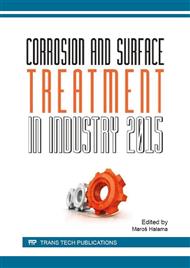[1]
F.P. Lees, Loss Prevention in the Process Industries - Hazard Identification, Assessment, and Controls, vol. 1-3, forth ed., Butterworth-Heinemann, Oxford, (2012).
Google Scholar
[2]
C. Movileanu, M. Mitu, V. Brinzea, A.M. Musuc, M. Mocanu, D. Razus, Adiabatic Flame Temperature of Fuel-Air Mixtures in Isobaric and Isochoric Combustion Processes, Rev. Chim. 62 (2011) 376-379.
Google Scholar
[3]
A. Pekalski, H. P. Schildberg, P. S. D. Smallegange, S.M. Lemkowitz, J.F. Zevenbergen, M. Braithwaite, H.J. Pasman, Determination of the Explosion Behaviour of Methane and Propene in Air or Oxygen at Standard and Elevated Conditions, Process Saf. Environ. 83 (2005).
DOI: 10.1205/psep.04211
Google Scholar
[4]
J. Turner, R. Pearson, B. Holland, R. Peck, Alcohol-Based Fuels in High Performance Engines, SAE Technical Paper 2007-01-0056.
DOI: 10.4271/2007-01-0056
Google Scholar
[5]
A. E. Farrell, R. J. Plevin, B.T. Turner, M. O'HARE, D. M. Kammen, Ethanol can contribute to energy and environmental goals, Science 311 (2006) 506–508.
DOI: 10.1126/science.1121416
Google Scholar
[6]
S. Kim, B.E. Dale, Global potential bioethanol production from wasted crops and crop residues, Biomass Bioenergy 26 (2004) 361–375.
DOI: 10.1016/j.biombioe.2003.08.002
Google Scholar
[7]
M. J. Lau, M. W. Lau, C. Gunawan, B. E. Dale, Ammonia fiber expansion pretreatment, enzymatic hydrolysis, and fermentation on empty palm fruit bunch fiber for cellulosic ethanol production. Appl. Biochem. Biotechnol. 162 (2010) 1847-57.
DOI: 10.1007/s12010-010-8962-8
Google Scholar
[8]
CH. Morley, GASEQ, A Chemical Equilibrium Program for Windows. Ver 0. 79 Jan 2005. Available at: http: /www. c. morley. dsl. pipex. com/gaseq079su. zip.
Google Scholar
[9]
M. Skřínská, J. Skřínský, P. Dolníček, P. Lukešová, R. Přichystalová, C. Serafínová, BLEVE - Cases, Causes, Consequences and Prevention, Mater. Sci. Forum 811 (2014) 91-94.
DOI: 10.4028/www.scientific.net/msf.811.91
Google Scholar
[10]
M. Skřínská, J. Skřínský, V. Sluka, J. Senčík, S. Malý, G. Tetu, Mathematical models for the prediction of heat flux from fire balls, WSEAS Transactions HAMT 9 (2014) 243-250.
Google Scholar
[11]
J. Skřínský, V. Sluka, J. Senčík, M. Pražáková, S. Malý, Application of emergency planning criteria for the control of major accident hazards-calculation of the consequences of fire accidents (2014).
DOI: 10.1201/b15938-20
Google Scholar


